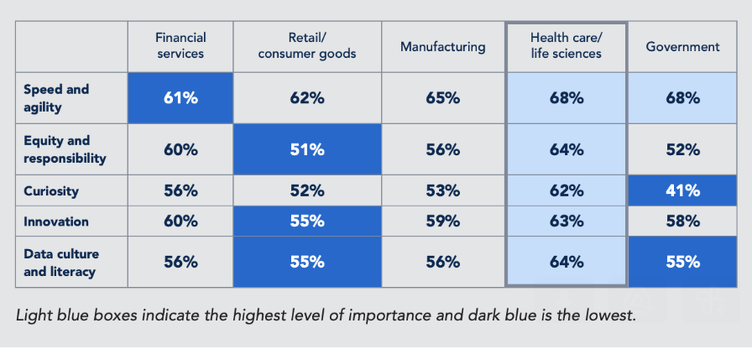Comments
- No comments found

If the past few years have taught us anything, it is to expect the unexpected.
Disruptions, challenges, and changes have become the new norm. In the face of such uncertainty, companies need to cultivate resilience to thrive. However, a recent study by analytics leader SAS Software reveals some interesting insights about the state of resilience in organizations.
In the SAS Resiliency Rules Report, the long-time analytics leader explores business resiliency for companies in industries like financial services, retail, manufacturing, health care and government. In this comprehensive study, SAS surveyed 2,414 senior executives at companies with more than 100 employees. Nearly all (97%) executives believe resiliency is very or somewhat important, yet less than half (47%) perceive their company as resilient.
Participating executives, however, are not sitting back waiting for an epiphany. One of the most interesting stats is that 80% are investing in resiliency planning and strategy.
Before we explore further, let’s define resiliency. According to Merriam-Webster, resiliency is defined as “the ability to recover or adjust easily to adversity or change.” Seems a little vague, almost like saying you’re on standby to prepare a dinner party for a dozen guests without knowing the date, theme or who’s invited.
The Latin word “resilire,” means the act of rebounding. Author Robert Jordan uses trees to describe resiliency. I love nature, and his quote resonates. He writes: “The oak fought the wind and was broken, the willow bent when it must and survived.”
The takeaway: Resiliency comes from inside. It is everywhere and deeply rooted. Prioritizing resiliency means weaving it into leadership and workplace culture. To me, resiliency is not about bouncing back, it’s about growing stronger and thriving in the face of challenges.

Resiliency is a collective effort that requires organizations to embrace a set of resiliency rules to foster a resilient mindset. Like the foundation of a house, each resiliency rule builds on another. From the report, here are SAS five rules to foster resilience in your company.
1. Speed and agility: Respond with quick shifts
2. Innovation: Create a better world
3. Equity and responsibility: Ensure fairness
4. Data culture and literacy: Instill analytics everywhere
5. Curiosity: Encourage exploration
For example, rule number one emphasizes the importance of speed and agility, closely tied to technology adoption. The study found that 68% of respondents are leveraging data, analytics and AI to outperform competitors, followed by cybersecurity and digital transformation efforts.
I love that rule number. two and three are rooted in values and culture. Innovation comes from a hunger to improve and find new solutions. Equity and responsibility means ethical standards are applied. Here, look at three markers: topline (growth), greenline (ESG) and bottomline (financials) is crucial for long-term resilience.
Rule number four addresses the need for a data-driven culture and understanding other people’s data. A silo approach to data across a company – finance, HR, marketing, operations – comes at a cost. It requires an equal amount of time to turn data into actionable insights as it does to produce data. From this, people become more productive and do more meaningful work, not just to meet department goals, but for the company as a whole. I once worked with a company that rewarded the HR department with a 120% bonus, based on the number of new hires they made. In other areas, however, the company was struggling. Why? Those new hires were fueled by high turnover. Siloed data and analytics create blind spots.
Curiosity, Rule number five, is one of my favorites. I’ll make a bold statement here, and stand by it: curiosity and corporate culture often do not gel. If you work for a company, you know that challenging the status quo can work against you. Yet, curiosity inspires innovation. Perhaps the key is to foster curiosity in a structured way, assigning initiatives for people who have curiosity in specific practice areas.
So, how can you be assured your company can navigate shifting waters you haven’t yet reached? Leave it to a company obsessed with analytics to develop an analytical tool to determine just that.
In addition to the SAS Resiliency Rules Report, SAS went a step further and developed a free, online Resiliency Assessment Tool. In less than five minutes, you can identify your company’s resiliency quotient based on its “resiliency rules.”
The assessment benchmarked me against 2,400 other participants. I remember thinking the 16 questions it asked were spot on. The survey addressed the role of resiliency in my industry, the level of curiosity my organization uses in data and analytics and the level of resiliency in my organization. The assessment was a good starting point for me to fill resiliency gaps I didn’t even know existed.
SAS is known to be committed to its employees and very customer-centric. SAS has been a privately-held company for 47 years (Dr. Jim Goodnight has been its sole CEO – amazing as CEO tenure continues to dip to just 6.9 years), staying strong after acquiring 14 companies and declining an acquisition by Broadcom. Now, SAS is on its way toward being IPO-ready by the end of 2024.
SAS, as a company, tells a story of resiliency.
There are leadership lessons to be learned from SAS. In an interview on Medium with Jennifer Chase, executive vice president and chief marketing officer for SAS, she talks about Goodnight’s tenure. “Dr. Goodnight’s endurance, adaptability, employee engagement, and social responsibility demonstrate his resilience as a leader and his ability to lead SAS through challenges and uncertainties while maintaining its long-term success.”
Resilience is a concept SAS understands very well, which lends even more meaning to its report.
Drawing inspiration from personal experience, I vividly recall facing uneven terrain, unexpected weather, equipment failures, and my own body’s reaction to thinning air while climbing Mount Everest base camp. Without resilience, I would not have made it to my goal of 18,000 feet. In the midst of uncertainty, I discovered profound opportunity and embraced gratitude. These came by way of encouragement from the sacred promise I made to grandma, invaluable lessons from my sherpa and my unwavering determination to succeed propelled me forward. This journey taught me that when resilience is summoned, remarkable accomplishments await. The same holds true for businesses that cultivate resilience - they unlock their full potential and achieve extraordinary heights amidst adversity.
Helen Yu is a Global Top 20 thought leader in 10 categories, including digital transformation, artificial intelligence, cloud computing, cybersecurity, internet of things and marketing. She is a Board Director, Fortune 500 Advisor, WSJ Best Selling & Award Winning Author, Keynote Speaker, Top 50 Women in Tech and IBM Top 10 Global Thought Leader in Digital Transformation. She is also the Founder & CEO of Tigon Advisory, a CXO-as-a-Service growth accelerator, which multiplies growth opportunities from startups to large enterprises. Helen collaborated with prestigious organizations including Intel, VMware, Salesforce, Cisco, Qualcomm, AT&T, IBM, Microsoft and Vodafone. She is also the author of Ascend Your Start-Up.
Leave your comments
Post comment as a guest